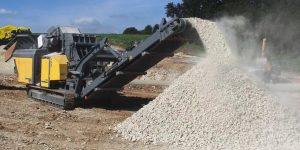Use Portland Cement in concrete for bridges, walls, culverts, floors, pavements, sidewalks, pipe, railway structures, reinforced concrete buildings, tanks and reservoirs, as well as for masonry units and other precast products.
Portland cement
Portland cement clinker is a dark grey nodular material made by heating ground limestone and clay at a temperature of about 1400 °C – 1500 °C. The nodules are ground up to a fine powder to produce cement, with a small amount of gypsum added to control the setting properties.

- Type I – Normal/General Purpose
Portland cement type 1 or general purpose is the most used of all cements and is suitable for all uses where special properties of other types are not required, with an average rate of heat evolution and strength development. It is used where cement or concrete are not subject to specific exposures, such as sulfate attack from soil or water, or an objectionable temperature increase due to the heat generated by hydration. Its uses include sidewalks and pavements, reinforced concrete buildings, bridges, railway structures, tanks, deposits, sewers, water pipes and masonry units.
CEM I is pure (100%) OPC (Ordinary Portland Cement)
- 32.5
- 42.5
- 52.5
- Type II – Moderate Sulfate Resistance
Portland cement is used when it is important to take precautions against moderate sulfate attack, such as in drainage structures where sulfate concentrations in groundwater are higher than normal but not unusually severe. Type II cement will generally generate less heat at a slower rate than Type I. With this moderate heat of hydration (an optional requirement), Type II cement can be used in large-mass structures, such as large piers, heavy pillars and retaining wall. Its use will reduce the temperature rise, especially important when the concrete is placed in a warm climate. CEM II is a mixture of OPC and additives such as fly ash, slag or limestone, up to a maximum additive content of 35%.
- 32.5
- 42.5
- 52.5
Grades of Cement – 28-Day Strength
Within each type there are three grades, based on the 28-day strength of the concrete that they produce. The grades are 32.5, 42.5 and 52.5 (sometimes written 33, 43, 53).
Classes of Cement – Strength Gain
Each grade consists of 3 classes which describe the speed at which the concrete made from them gains strength:
R = early strength gain
N = normal strength gain
L (or S) = low/slow strength gain.
- Clinker
Clinker is primarily used to produce cement. Since it can be stored in dry condition for several months without noticeable deterioration, it is traded internationally in large amounts. Cement manufacturers buy clinker for their cement plants in areas where raw materials for cement are scarce or unavailable


